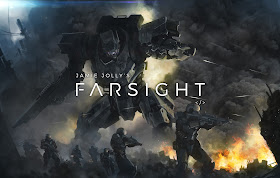Big bastard robots!
That's what my podcast co-host and Polyhedron Collider writer said to me when I showed him some details about Farsight, the new game from Braincrack games that the entire Polyhedron Collider crew got to play on Tabletopia this week along with Lewis from Braincrack. And the game certainly is about big bastard robots, with a mix of game-play from Space Marine, Stratego and Heroes of Normandie.
It's the near future blah blah blah, corporations blah blah blah, war! You don't need to know the back story, the important thing to remember is that like chucking out time in Wrexham town centre, it's all about to kick off but instead of fighting over your position in the kebab shop queue, you'll be fighting over key strategic bases spread over the board.

Here's where the game really does feel like the early 90s Space Marine miniatures game. There are 12 objective points, spread evenly across a gridded map of forests, mountains, lakes and hills, each offering some form of tactical advantage (apart from lakes, no one can move through lakes, lakes are arseholes). To win you're going to have to take and hold a set number of these strategic bases.
If you're an old Space Marine fan (and I'm talking many years before it became known as Epic 40,000), then this will feel a little familiar and cosy, like a pre-warmed sweater on a winter’s day. The other aspect that feels like Space Marine is that you will be commanding a selection of infantry, artillery and the aforementioned big bastard robots, which also come in a number of flavours such as ‘sprinty but not quite as big bastard robot’ and ‘double hard weapons platform behemoth bastard robot’.
But there's a twist. Something that changes Farsight from your ‘here's some troops on a map game’ we've seen a thousand times before to something very special.
Farsight is a hidden movement game.
As you deploy your units to the board you place them face down, meaning your opponent has no idea if you have placed a unit of squishy infantry or a 70-foot-tall metal death machine. This is where Farsight really shines. It adds another layer of strategy to a familiar format, forcing you to guess your opponent’s formations and add bluffing to your own tactical arsenal. But there's also another layer to add to Farsight; specialists.
Specialists are single units like snipers, spies and saboteurs, which instead of being placed on the board their location is secretly noted on a shadow map. These units can hinder movement, reveal the identity of units and generally cause mischief and mayhem. All of them are fun to use and because they can't move their initial placement is paramount.
I've neglected to mention any aspect of the actual rules because I don't really need to as the game flows so smoothly, the strategy and placement of your troops becomes your main concern. Combat is a simple case of rolling some dice and totting up the number of explosion symbols. There are modifiers that can affect how many dice you can roll, such as the terrain and flanking but these are quickly assessed and the dice get chucked quickly. And it should be said that there are plenty of dice to chuck, meaning you are rarely beholden to the fate of a single plastic cube. If dice aren't your thing then rules are available to play the game deterministically, with unit stats compared and a set amount of damage being dealt.
What felt really weird at first is that there are no defence dice, so every hit rolled causes damage. It should be highlighted that the defender also rolls dice, so a good defensive unit can deal out some serious damage in retaliation. The other aspect that can feel counter intuitive is that every unit has exactly that same amount of health. From tiny meat sacks to huge robots, every unit can take exactly 3 damage. At first, this feels rather odd and it's something some people are not going to get along with. Personally, I liked it, it made the game simpler to track and means that the defensive capability of a unit is all about how hard it hits back, rather than how much damage it can shrug off.
Before we round off this review I want to mention minis. Braincrack Games have shown off some very impressive digital sculpts for this game, and if you’re a plastic crack addict they are going to be a nice addition to your collection. However, these are optional. Farsight can be played with tokens and chits and it doesn't lose anything. In fact, we played the game via Tabletopia, using virtual cards and tokens, and never once felt the game had lost out because of a lack of miniatures.
Farsight has a lot of strategic options, a new hidden movement twist on the tactical war game and a lovely crescendo as the carnage ramps up as the game moves forward. Farsight’s hidden information brings something new to the genre, whilst still being slick to play and offering plenty of depth. I suggest you go check it out.
Farsight is on Kickstarter now.
This Kickstarter preview is based on a prototype version of the played over Tabletopia with the publisher; the final product may look, play or smell different to that used in this preview.





No comments:
Post a Comment